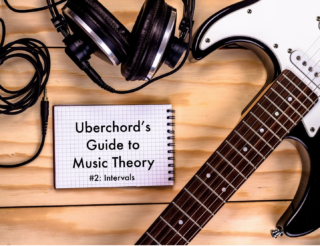Everything You Need To Know About The Gmaj7 Guitar Chord
Author: Matthew King

Chords like the Gmaj7 guitar chord are a mystery to many guitar players as you won’t see it as much as the popular G chord. Playing the chord will bring to mind sunshine and rainbows instead of grungy aggression or cool jazz vibes. That makes this chord a little tricky to use, but it’s actually a fascinating chord to use!
Once you learn this chord, you can start to figure out how to add more depth and more sophistication to your chord progressions. Once you learn the ins and outs of the G major key, you’ll see many opportunities to use the maj7 interval in a way that’s interesting and musical. Finally, you’ll have another option for chord strumming if you’re sick of the basic chords like G, C, and D.
In this article, we’re going to cover the theory of the Gmaj7 guitar chord, a few songs that use this chord, a little bit about the lydian mode, as well as how to easily remember the chord shapes of the Gmaj7 guitar chord. Are you ready?!?!?
Table of Contents
Theory Behind The Gmaj7 Guitar Chord
If we’re looking at the Gmaj7 guitar chord through the key of G major, we’ll get the following set of chords:
G major scale = G – A – B – C – D – E – F#
Gmaj7 = G – B – D – F#
Cmaj7 = C – E – G – B
D7 = D – F# – A – C
Em7 = E – G – B – D
Bm7 = B – D – F# – A
Am7 = A – C – E – G
In case you don’t know, the construction of every major scale consists of a series of whole steps and half steps as follows: W W H W W H. This gives you a set of notes that’ll help you build 3 major chords, 3 minor chords, and 1 diminished chord. The maj7 chords are created from the I (G) and IV (C).
We call these 7th chords, extended chords, or polychords depending on their context. However, to make a maj7 interval on any chord, you just add the note that’s a half step down from the root (F# in the case of Gmaj7), and put it in the appropriate place.
There are thankfully several stock chord shapes that many guitarists will use to create this harmonic sound:
Hopefully you’ll notice their similarities to the relevant major chord shapes, but if not, I’ll show you some tricks for remembering these shapes later in the article. Let’s look at some real live music now……
Songs That Use The Gmaj7 Guitar Chord Shape
The first song we’re starting with is a Jazz standard that’s covered by many aspiring guitarists:
Autumn Leaves (Am7 – D7 – Gmaj7 – Cmaj7 – F#m7b5 – B7 – Em)
The reason we started with a breakdown of the Gmaj7 guitar chord’s theory is so that you can see the structure influencing all of this. If you read the last section, you should easily see how all of these chords work together. This is not random!
Now let’s look at one song by Sir Paul McCartney with Wing’s “Band On The Run”
(Dmaj7 – Gmaj7)
Some versions of this song have no Gmaj7, but it’s in the key of D major so the IV (G) can easily work as a maj7 chord. This is the great thing about theory. Once you know and understand the makeup of a musical key you’ll know what chords will work if you stay in that key.
This next song is originally played in an alternate tuning, but the harmony does use a Gmaj7 chord in the opening bars. Here’s the “Rain Song” by Led Zeppelin:
(G5 – Gmaj7 – G7 – Eb/G – G6)
Thankfully, this and our other examples have been in a key that has a Gmaj7 guitar chord. However the next one does not. Many rock bands don’t use these chords because they have a very particular sound that won’t suit bands like AC/DC, Metallica, or Rage Against The Machine. Pink Floyd however used maj7 chords and others quite a bit:
Here’s a chord progress from Pink Floyd’s “Time” in D lydian/A major. We’ll discuss Lydian modes in the next section……
(Dmaj7 – Amaj7 – Dmaj7 – C#m7 – Bm7 – E – F#m)
The Secret To Using The Lydian Mode
At a certain point in a guitar player’s journey, you may or may not get mystified and intrigued by the musical modes. In my opinion, the modes are not THAT important of a concept to understand music, and you’re more than likely not going to need them all that much. However, in cases like Pink Floyd’s music up above, they can illustrate some secrets to their usage.
Let’s break down the notes and chords available from D Lydian, used in “Time:”
D major scale (2 sharps) = D – E – F# – G – A – B – C#
D Lydian = D – E – F# – G# – A – B – C#
A Major Scale (3 sharps) = A – B – C# – D – E – F# – G#
Dmaj7#11 = D – F# – A – C# – G#
Amaj7 = A – C# – E – G#
E7 = E – G# – B – D
Bm7 = B – D – F# – A
C#m7 = C# – E – G# – B
I put the first chord as Dmaj7#11 for an important reason. This is the key lydian chord available in this mode, and yes it’s available in any major scale too (as you’ll get the same notes). What makes a chord progression “lydian” sounding is using the #11 available through this set of notes.
The other thing to remember is that you must start and repeat on the relative I chord, which in this case is D major. That’s it. That is how you use modes to create music! Just take any of the other 2 major chords, 3 minor chords, or the 1 diminished chord (if you’re feeling froggy!) and make a chord progression.
How To Easily Remember This Chord
Maybe now you see why we’re UberChord and NOT UberScale. Chords, not scales, are the key to understanding how lots of music really works. So even though this is just a small dip into theory, it’s important to remember these chords, and we have a few tips as to how to do that.
Take a look at each of these chord diagrams, and try to see how they’re just barely different:
Everything we just discussed in this article about the Gmaj7 guitar chord all boils down to adding just one note into the mix (F#). This note gives us all sorts of new musical possibilities and thus can conjure lots of new chords. That’s why we hope you’ll download the UberChord app so you can keep up with all of this new knowledge!








No comments yet - be the first.